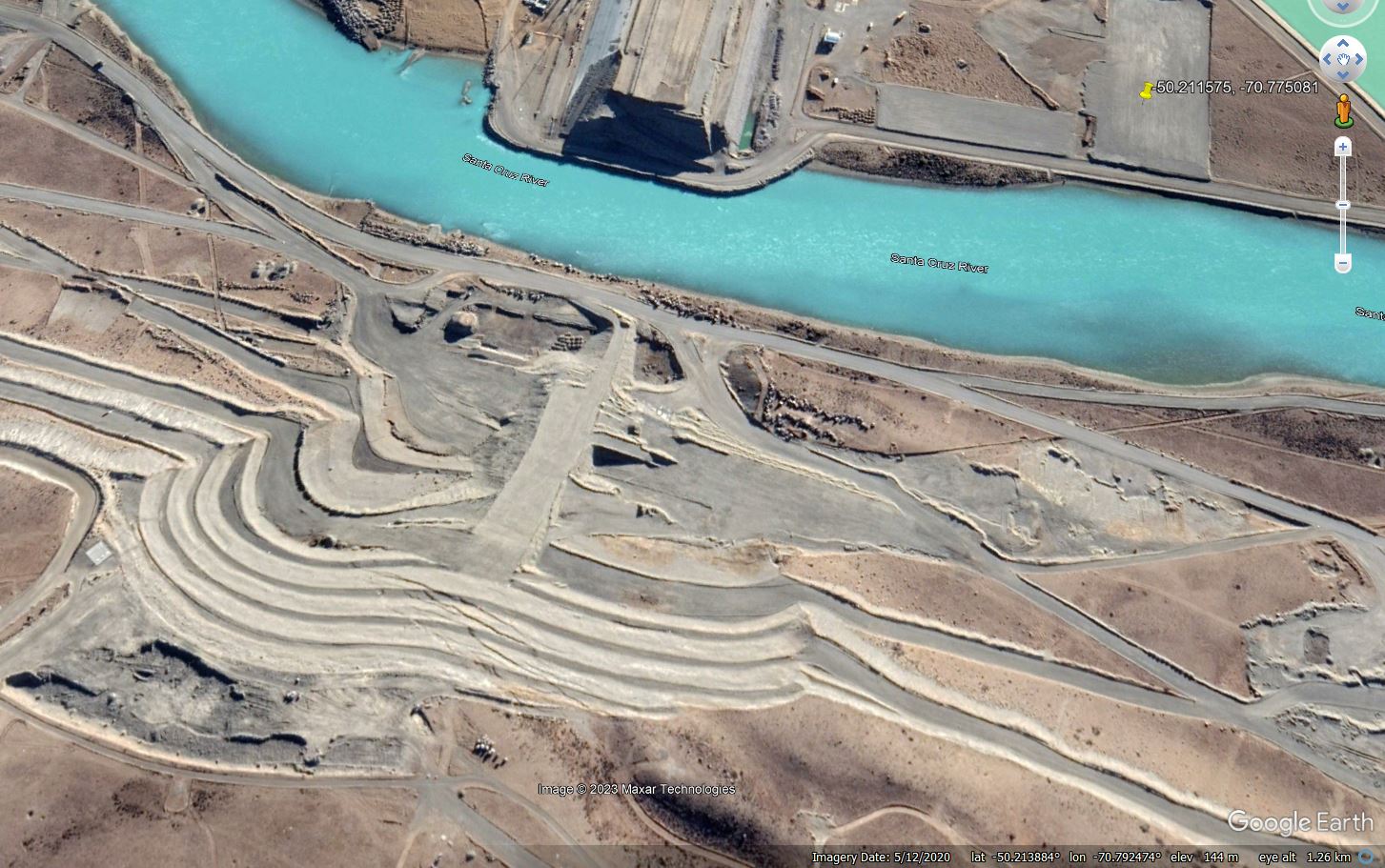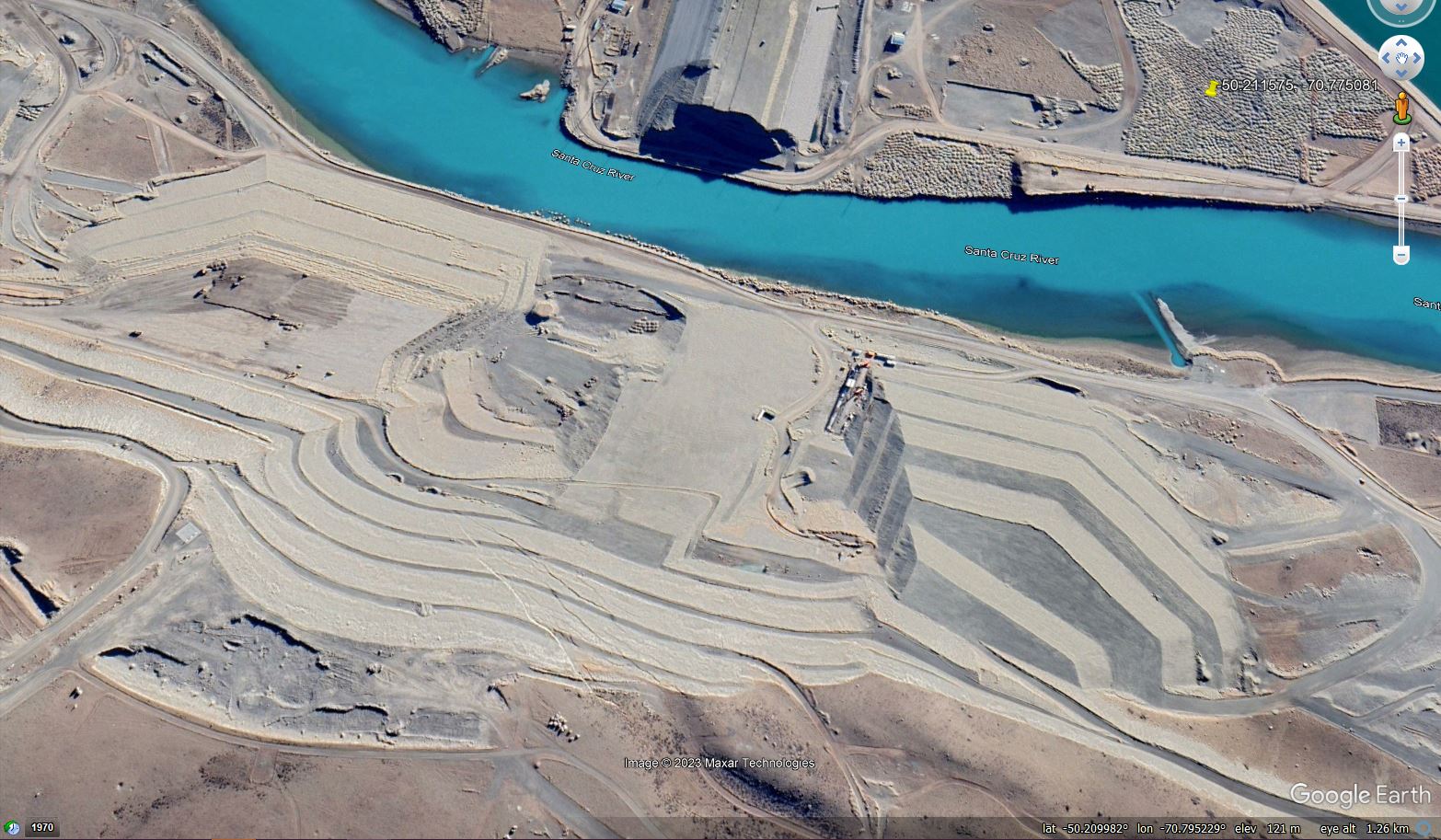8 June 2023
Instability in ground works at the Cóndor Cliff dam in Argentina
Posted by Dave Petley
Instability in ground works at the Cóndor Cliff dam in Argentina
On a day in which a large dam is very much in the international news, I came across an interesting article that has just been published in Open Access format in the journal Natural Hazards and Earth System Sciences (Tamburini-Beliveau et al. 2023) regarding instability in ground works at the Cóndor Cliff dam in Argentina. This is a large dam that is under construction, located at [-50.214, -70.781]. The dam will be a concrete face rockfill dam (CFRD), 75 metres high and 2,780 metres long according to Wikipedia, impounding a reservoir of 14 million cubic metres and generating an installed capacity of 1,140 MW.
Tamburini-Beliveau et al. (2023) describe a site with acute geological challenges, including weak and poorly compacted bedrock, predisposition to instability and the presence of faults. Although construction started in 2015, instability at the site meant that the design had to be changed, and some of the works had to be removed.
The paper uses PSI DInSAR to examine deformation of the southern abutment of the dam, which had reported slope instability during 2018 and 2019. They point out that the deformation is visible on publicly available imagery. This is a Google Earth image from May 2020 of the site:-

Google Earth image of the groundworks at the Cóndor Cliff Dam in Argentina in May 2020.
.
In the ground works in the lower centre of the image a series of large, sub-parallel cracks can be clearly seen. These extend over a distance of about 250 m along the length of the cracks and 50 metres in width. There is a further image, probably from May 2022 (an exact date is not given in Google Earth), that also shows these cracks:-

Google Earth image of the groundworks at the Cóndor Cliff Dam in Argentina, possibly in May 2022.
.
The DInSAR work of Tamburini-Beliveau et al. (2023) indicates that instability at the Cóndor Cliff Dam started in early 2019 and was continuing in April 2021, at the end of the data series. Deformation was also recorded on the slopes around the northern abutment. Peak deformation rates of 32 mm per year were recorded.
There is little information about the ways in which these engineering challenges are being addressed that I can find. Does anyone have any information?
.
Reference
Tamburini-Beliveau, G., Balbarani, S., and Monserrat, O. 2023 Brief communication: Landslide activity on the Argentinian Santa Cruz River mega dam works confirmed by PSI DInSAR, Natural Hazards and Earth System Sciences, 23, 1987–1999, https://doi.org/10.5194/nhess-23-1987-2023, 2023.


 Dave Petley is the Vice-Chancellor of the University of Hull in the United Kingdom. His blog provides commentary and analysis of landslide events occurring worldwide, including the landslides themselves, latest research, and conferences and meetings.
Dave Petley is the Vice-Chancellor of the University of Hull in the United Kingdom. His blog provides commentary and analysis of landslide events occurring worldwide, including the landslides themselves, latest research, and conferences and meetings.
ESA continues to develop free, open-source toolboxes for processing EO (Earth Observation) mission products. STEP (Scientific Toolbox Exploitation Platform) is the ESA community platform for accessing the software and its documentation, providing tutorials and material for training scientists using the SNAP (Sentinel Application Platform) Toolboxes. https://step.esa.int/main/ The Sentinel-1 toolbox for radar and Sentinel-2 toolbox for multi-spectral imagery are included in the basic software installation. https://step.esa.int/main/download/snap-download/
Satellite data is also free. https://scihub.copernicus.eu/dhus/#/home
It’s not a simple process, but well developed and supported by documentation and tutorials.
Hello,
I am the main author of the paper. It is a real joy to know that our work has come to the attention of the AGU. Not only because of the professional recognition it entails, but mainly because of the consolation that comes from knowing that such an important problem has crossed the borders of our remote region.
I tried twice to post a comment but due to some reason I can not make it appear in the blog.
Now, in a more breif comment I wan to tell to the possible readres to not hesitate to contact me if they are interested in the subject.
Thank you very much
(Sorry, I sent by mistake the uncorrected version, please, keep this one)
Hello, I am the main author of the paper. It is a real joy to know that our work has come to the attention of the AGU. Not only because of the professional recognition it entails, but mainly because of the consolation that comes from knowing that such an important problem has crossed the borders of our remote region.
I tried twice to post a comment but due to some reason I can not make it appear in the blog. Now, in a more brief comment I want to tell the possible readers to not hesitate to contact me if they are interested in the subject.
Thank you very much